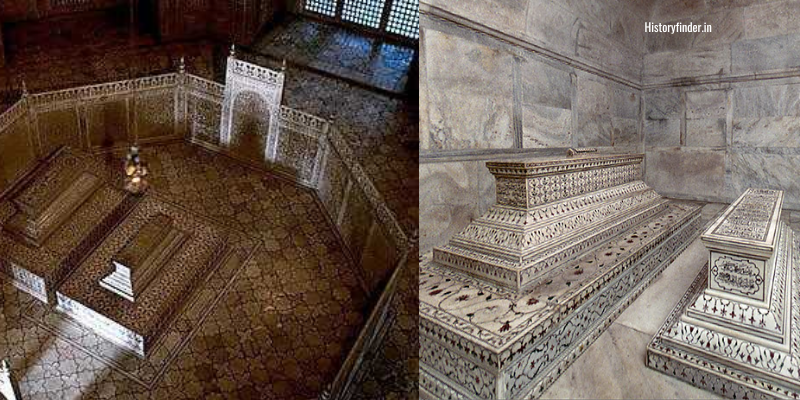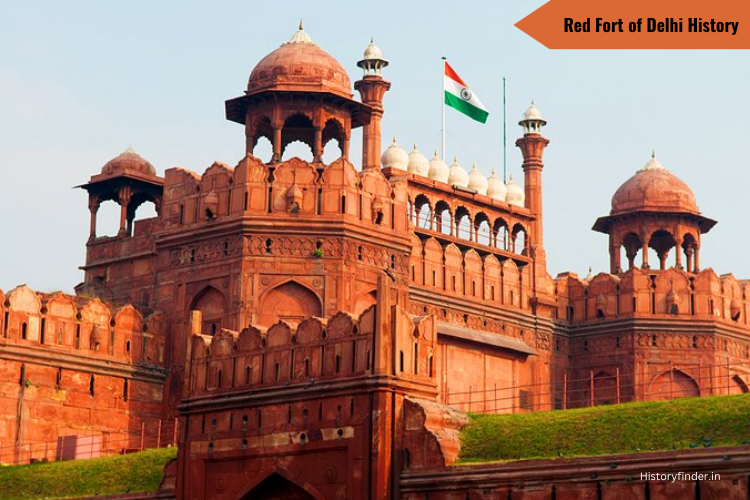Agra Taj Mahal is a mausoleum, an architectural masterpiece and a national heritage monument, situated at the city of Agra in Uttar Pradesh, India. The ivory-white marble made iconic memorial had once glorified the Mughal era, is now a national pride of India. Alongside the legendary love story, Agra Taj Mahal history contains many unknown, yet fascinating facts.
Agra Taj Mahal is regarded as one of the best representation of Indo-Islamic architectures of Mughal era. In 1983, UNESCO had declared Agra Taj Mahal a World Heritage Site as the jewel of Islamic art in India. The eye catching monument is also admired globally among the world’s best heritages. In 2007, the New 7 Wonders of the World campaign of 2001 had declared Agra Taj Mahal a wonder among the new 7 wonders of the world.
Agra Taj Mahal brief history
Mughal emperor Shah Jahan built Agra Taj Mahal in 1648 CE, in memory of his favourite wife Mumtaz Mahal. The main mausoleum building of Agra Taj Mahal actually houses the tomb of Mumtaz Mahal. Shah Jahan’s extreme love and affection for his life Mumtaz produced the idea of constructing the grand mausoleum of Taj Mahal.
Shah Jahan had four wives. But according to the contemporary historians, the emperor didn’t show similar affections for his other wives ever. Mughal emperor Shah Jahan married to Mumtaz Mahal in 1612 CE. Mumtaz was his second wife. After her death, he avoided royal affairs for several days in his grief. Further, he gave up his luxurious living for several months.
Mughal emperor Shah Jahan laid the foundation of Agra Taj Mahal in 1631, same year Mughal empress Mumtaz Mahal died. However, the tomb of Mumtaz Mahal along with the main mausoleum building was completed in 1648.
Agra Taj Mahal: 15 fascinating facts worth knowing
1. Love for Mumtaz Mahal
The story of Shah Jahan and his wife Mumtaz Mahal often comes around Agra Taj Mahal history. Interestingly, Mumtaz Mahal died at the age of 40 years, while giving birth to her 12th child. Nevertheless, it depicts Mughal emperor Shah Jahan’s immense love for his wife, who eventually decided to build her mausoleum in such a grand fashion.
Mughal emperor Shah Jahan had spent his last days in memory of his dearest wife, Mumtaz Mahal. In fact, his construction of Shahi Burj inside the Agra fort had this specific reason only. Mughal emperor Aurangzeb, his son and successor, however fulfilled his last dream but in an unkind manner. Aurangzeb imprisoned his father Shah Jahan in 1658, at Shahi Burz in Agra fort. Shah Jahan eventually died there in 1666.
2. Taj Mahal architecture
Emperor Shah Jahan and his chief architect Ustad Lahori followed their own, Mughal architectural style, a classic mix of Indian and Islamic architecture. The main mausoleum building was inspired from Humayun’s tomb of Delhi and Timur’s tomb of Samarkand, Uzbekistan. It is basically a cube with chamfered corners, which gives the base structure a eight sided shape. Each side has symmetrical iwans with pishtaq in each side and large onion dome on the top. The dome finial has the tamga of the Mughal empire. All the shapes and symbols are symmetrical from all four sides, shaping the architectural brilliance of Agra Taj Mahal.

Other buildings inside Taj Mahal premise are all in combinations of red and white stones. From the architectural perspective, all other buildings were built in traditional Mughal architecture.
3. Design of Taj Mahal
Ustad Ahmad Lahori was the mastermind behind the lavishing design of Agra Taj Mahal. He had appointed a team of 37 designers and architects to work under him to prepare Agra Taj Mahal design. In fact, Mughal emperor Shah Jahan had also played an active role during the in-progress design work. Several accounts mention that he would discuss every stage of developments in detail on regular basis.
A perfect bilateral symmetry along an axis, is the salient feature of Taj Mahal design. The axis runs through the center of the main dome and the surrounding gardens. Tal Mahal minarets at four corners, slightly tilted outwards, further emphasize the symmetry.
4. Agra Taj Mahal construction
Taj Mahal main building (the mausoleum) construction took 16 years of hard work and efforts, which began in 1631 CE, and went until 1647. The exquisite decoration work of Taj Mahal itself went for four years (1643-47 CE). Chief architect Ustad Ahmad Lahori had deployed more 20,000 people including artisans and workers for the construction of Agra Taj Mahal. However, the construction period of entire Taj Mahal complex was 21 years, since the other buildings, boundary walls, and the four gardens took another five years (1647-53).
The ivory-white marbles were brought from Makrana village of Rajasthan. Another famous story exists regarding Agra Taj Mahal is its logistics and transportation. About a 15 km (9.3 miles) long earthern ramp for transport marble and materials to the construction site was indeed a key part of construction. Thousands of oxen and elephant carts were used for such a massive transportation.
5. Change of colour with changing light
The ivory-white Makrana marbles of Taj Mahal reflect light lights in different colurs with time and seasonal variations. Taj’s true colours is visible during the full sun-shine hours only. But it reflects thre other colours which equally attracts the tourists and Taj lovers. Morning sunlight reflects a soft, golden colour while sun set vibe leaves a yellow hue across the monument. However, view of Taj Mahal at full moon in the most eye catching among the four colours of Taj Mahal.

6. Expensive motifs and decorations at Taj Mahal
Mughal emperor Shah Jahan showed extreme level of passion while decorating his favourite wife’s mausoleum. Taj Mahal structure carries exquisite decorations with colourful reliefs, using Parchin Kari technique. About 28 different types of semi-precious stones are in use. Shah Jahan had spent a huge amount of money in sourcing the stone from various parts of India, Asia and Middle East countries.

Some of the semi precious stones inlaid in the exquisite marble work include: red and orange carnelians, green jades, blue lapis lazulis, jaspers, blue turquoises, sapphires, green malachites etc. Stones like carnelian came from Arabia, jade from China, jasper from Punjab, lapis lazuli from Afghanistan, turquoise from Tibet, and sapphires from Sri Lanka. Agra Taj Mahal had tiny gold and silver decoration work at many areas as well.

7. Finial of Taj Mahal
Taj Mahal main dome originally had a gold finial. But later during early 19th century, the gold finial was replaced with a gilded bronze replica. The finial tops by a moon, typically an Islamic motif. A horn from the center of the moon points towards the heaven. Taj Mahal finial actually represents the tamga of Mughal empire.

8. Agra Taj Mahal project cost
The ivory-white Makrana marbles, semi-precious stones, silver and gold plates, the golden spire, the buildings, all sums up to massive construction cost. Taj Mahal complex is believed to have an estimated cost about 5 million Mughal Rupees, which in present values, would be approximately INR 80 billion (US$ 1 billion).
Many historians have termed such expenses as ‘needless’ and one of reason of financial collapse of the mighty Mughal empire. Several historians and experts also take this as a reason of Shah Jahan’s house arrest as well.
9. Tomb planning of Shah Jahan: Story of Black Taj Mahal
Mughal emperor Shah Jahan had his own plan for heaven with her favourite wife, Mumtaz Mahal. The ruined blackened marbles of Mehtab Bagh has a fascinating and legendary story story about Black Taj Mahal of Shah Jahan. According to that famous story, the empror had already began construction work of an completely identical mausoleum to Taj Mahal for himself. However, the black marbles once indicates that it could be a black twin, on the other bank of river Yamuna. The famous myth of Black Taj Mahal of Shah Jahan also mentions that Shah Jahan had planned to connect these twins (mausoleums) with a bridge over the river Yamuna. However, Mughal emperor Auragzeb, finally deposed him at Agra fort to stop such needless expenses.

The Archaeological Survey of India (ASI) conducted an excavation work in 1990, which proved the myth of Black Taj Mahal completely wrong. It was all white stone which truned black in due course of time.
10. Original and metaphoric tombs of Mumtaz and Shah Jahan
Shah Jahan couldn’t get his dream tomb after death. His son Aurangzeb eventually buried his father at Taj Mahal, beside his mother’s tomb. The main chamber of Taj Mahal houses two false cenotaphs of Shah Jahan and Mumtaz Mahal. The original sarcophagi of the duo are actually apprears at the lower level.

Both the original and false tombs of Shah Jahan and Mumtaz Mahal has exquisite semi-precious stones inlay work. During 1633, on the occassion of second death anniversary Mumtaz Mahal, Shah Jahan covered her cenotaphs by a screen of gold. Later considering the security aspects, he replaced that with marble screen (mahjar-i mushabbak). Both the marble screen and the tombs of the duo have extremely delicate motif inlay work. However, the original cenotaphs at the basement have much lesses decorations.
11. Initial leakage problem at Taj Mahal
Agra’s architectural masterpiece too had faced some initial challenges due constructional flaws. In December 1652, prince Aurangzeb wrote a letter to his father, mentioning about the leakage at Taj Mahal buildings. The mausoleum building and the mosque had suffered from heavily from water leakage in the past monsoon. The leakages, however, were repaired later by Shah Jahan.
12. Jat invasion at Taj Mahal
Jat rulers of Bharatpur invaded Agra and Taj Mahal in early 18th century. They plundered many valuable items from the mausoleum. The screens of gold and silver from the central hall, golden finial from the central dome and two valuable chandeliers, one of silver and the other of agate stone are most significant among them. They even set some of the halls ablaze to melt the silver and gold from the decorated motifs.
13. Agra Taj Mahal was in state of disrepair
Lack of adequate maintenance had also caused today’s wonder Taj Mahal once being in a state of disrepair. Such unwanted situation arrived during the British rule in India, during late 19th century. Thankfully, the British also had been kind enough to protect the heritage monument. British viceroy Lord Curzon took the initiative and passed the order for restoration of Taj Mahal. The restoration work was eventually completed by 1908.
14. Protective scaffolding erection at Agra Taj Mahal
During the second world war, Japanese air strike threats went very high. In 1942, the British government erected a protective scaffolding to make Taj Mahal unrecognisable during war time.

Similar scaffolding was again made during the India Pakistan wars, in 1965 and 1971, to mislead the bomber planes.
15. Discolouration of Taj Mahal
Excessive envirmental pollution turned the ivory-white marbles of Taj Mahal into yellow-brown by the late 20th century. The Supreme Court of India passde the directives to set up the Taj Trapezium Zone (TTZ) around the monument. In 1997, the Goverment of India set up the zone, declaring 4,000 square mile area around Taj Mahal as TTZ. Strict air emission standards had been placed to prevent the asmospheric effect on the heritage monument.

